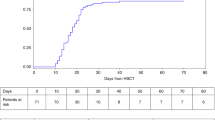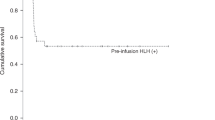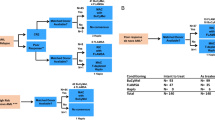Abstract
Hurler's syndrome is an inborn error of mucopolysaccharide metabolism leading to premature death in childhood. Allogeneic hematopoietic SCT can achieve long-term survival by correcting the enzymatic deficiency. In an attempt to improve long-term engraftment and to reduce regimen-related toxicity (RRT), a prospective multicenter approach was initiated in Germany using a fludarabine-based radiation-free preparative regimen. Between 2001 and 2008, 12 children were enrolled. Median age at SCT was 14 months (range, 4–31 months). The conditioning regimen contained fludarabine, BU, melphalan and antithymocyte globulin. CD34 positively selected PBSC were used in 10 children with a matched unrelated donor. Median cell dose was 24.6 × 106 CD34+ cells per kg (range 10.0–54.8). Two children with a matched sibling donor received non-manipulated BM. Donor lymphocyte infusions were given in 6/12 children for mixed hematopoietic chimerism. At a median follow-up of 29 months (range 2–85 months), all children engrafted and have either stabilized or improved neurological function. In total, 12/12 patients showed donor-derived engraftment with 9/12 having full and 3/12 having mixed hematopoiesis. One developed acute GVHD ⩾grade II. RRT ⩾grade II was observed in two patients.
This is a preview of subscription content, access via your institution
Access options
Subscribe to this journal
Receive 12 print issues and online access
$259.00 per year
only $21.58 per issue
Buy this article
- Purchase on Springer Link
- Instant access to full article PDF
Prices may be subject to local taxes which are calculated during checkout
Similar content being viewed by others
References
Aldenhoven M, Boelens JJ, de Koning TJ . The clinical outcome of Hurler syndrome after stem cell transplantation. Biol Blood Marrow Transplant 2008; 14: 485–498.
Peters C, Shapiro EG, Anderson J, Henslee-Downey PJ, Klemperer MR, Cowan MJ et al. Hurler syndrome: II. Outcome of HLA-genotypically identical sibling and HLA-haploidentical related donor bone marrow transplantation in fifty-four children. The Storage Disease Collaborative Study Group. Blood 1998; 91: 2601–2608.
Peters C, Balthazor M, Shapiro EG, King RJ, Kollman C, Hegland JD et al. Outcome of unrelated donor bone marrow transplantation in 40 children with Hurler syndrome. Blood 1996; 87: 4894–4902.
Guffon N, Souillet G, Maire I, Straczek J, Guibaud P . Follow-up of nine patients with Hurler syndrome after bone marrow transplantation. J Pediatr 1998; 133: 119–125.
Lang P, Handgretinger R, Niethammer D, Schlegel PG, Schumm M, Greil J et al. Transplantation of highly purified CD34+ progenitor cells from unrelated donors in pediatric leukemia. Blood 2003; 101: 1630–1636.
Grigull L, Beilken A, Schrappe M, Das A, Luecke T, Sander A et al. Transplantation of allogeneic CD34-selected stem cells after fludarabine-based conditioning regimen for children with mucopolysaccharidosis 1H (M Hurler). Bone Marrow Transplant 2005; 35: 265–269.
Nguyen L, Fuller D, Lennon S, Leger F, Puozzo C . I.V. busulfan in pediatrics: a novel dosing to improve safety/efficacy for hematopoietic progenitor cell transplantation recipients. Bone Marrow Transplant 2004; 33: 979–987.
Yeh H, June CH . Use of cell-based therapies for modification of host immune responses. Dev Biol (Basel) 2003; 112: 99–104.
Przepiorka D, Weisdorf D, Martin P, Klingemann HG, Beatty P, Hows J et al. 1994 Consensus Conference on Acute GVHD Grading. Bone Marrow Transplant 1995; 15: 825–828.
Vonderheide RH, June CH . A translational bridge to cancer immunotherapy: exploiting costimulation and target antigens for active and passive T cell immunotherapy. Immunol Res 2003; 27: 341–356.
Fleming DR, Henslee-Downey PJ, Ciocci G, Romond EH, Marciniak E, Munn RK et al. The use of partially HLA-mismatched donors for allogeneic transplantation in patients with mucopolysaccharidosis-I. Pediatr Transplant 1998; 2: 299–304.
Whitley CB, Belani KG, Chang PN, Summers CG, Blazar BR, Tsai MY et al. Long-term outcome of Hurler syndrome following bone marrow transplantation. Am J Med Genet 1993; 46: 209–218.
Souillet G, Guffon N, Maire I, Pujol M, Taylor P, Sevin F et al. Outcome of 27 patients with Hurler's syndrome transplanted from either related or unrelated haematopoietic stem cell sources. Bone Marrow Transplant 2003; 31: 1105–1117.
Boelens JJ, Wynn RF, O'Meara A, Veys P, Bertrand Y, Souillet G et al. Outcomes of hematopoietic stem cell transplantation for Hurler's syndrome in Europe: a risk factor analysis for graft failure. Bone Marrow Transplant 2007; 40: 225–233.
Staba SL, Escolar ML, Poe M, Kim Y, Martin PL, Szabolcs P et al. Cord-blood transplants from unrelated donors in patients with Hurler's syndrome. N Engl J Med 2004; 350: 1960–1969.
Sensenbrenner LL, Owens Jr AH, Heiby JR, Jeejeebhoy HF . Comparative effects of cytotoxic agents on transplanted hematopoietic and antibody-producing cells. J Natl Cancer Inst 1973; 50: 1027–1033.
Fried W, Kedo A, Barone J . Effects of cyclophosphamide and of busulfan on spleen colony-forming units and on hematopoietic stroma. Cancer Res 1977; 37: 1205–1209.
Thomas ED, Buckner CD, Rudolph RH, Fefer A, Storb R, Neiman PE et al. Allogeneic marrow grafting for hematologic malignancy using HL-A matched donor-recipient sibling pairs. Blood 1971; 38: 267–287.
Keating MJ, O'Brien S, Lerner S, Koller C, Beran M, Robertson LE et al. Long-term follow-up of patients with chronic lymphocytic leukemia (CLL) receiving fludarabine regimens as initial therapy. Blood 1998; 92: 1165–1171.
Chun HG, Leyland-Jones B, Cheson BD . Fludarabine phosphate: a synthetic purine antimetabolite with significant activity against lymphoid malignancies. J Clin Oncol 1991; 9: 175–188.
Santos GW, Tutschka PJ, Brookmeyer R, Saral R, Beschorner WE, Bias WB et al. Marrow transplantation for acute nonlymphocytic leukemia after treatment with busulfan and cyclophosphamide. N Engl J Med 1983; 309: 1347–1353.
Bearman SI . Veno-occlusive disease of the liver. Curr Opin Oncol 2000; 12: 103–109.
Handgretinger R, Klingebiel T, Lang P, Gordon P, Niethammer D . Megadose transplantation of highly purified haploidentical stem cells: current results and future prospects. Pediatr Transplant 2003; 7 (Suppl 3): 51–55.
Handgretinger R, Klingebiel T, Lang P, Schumm M, Neu S, Geiselhart A et al. Megadose transplantation of purified peripheral blood CD34(+) progenitor cells from HLA-mismatched parental donors in children. Bone Marrow Transplant 2001; 27: 777–783.
Kim YM, Mapara MY, Down JD, Johnson KW, Boisgerault F, Akiyama Y et al. Graft-versus-host-reactive donor CD4 cells can induce T cell-mediated rejection of the donor marrow in mixed allogeneic chimeras prepared with nonmyeloablative conditioning. Blood 2004; 103: 732–739.
Chakraverty R, Cote D, Buchli J, Cotter P, Hsu R, Zhao G et al. An inflammatory checkpoint regulates recruitment of graft-versus-host reactive T cells to peripheral tissues. J Exp Med 2006; 203: 2021–2031.
Bethge WA, Hegenbart U, Stuart MJ, Storer BE, Maris MB, Flowers ME et al. Adoptive immunotherapy with donor lymphocyte infusions after allogeneic hematopoietic cell transplantation following nonmyeloablative conditioning. Blood 2004; 103: 790–795.
Author information
Authors and Affiliations
Corresponding author
Rights and permissions
About this article
Cite this article
Sauer, M., Meissner, B., Fuchs, D. et al. Allogeneic blood SCT for children with Hurler's syndrome: results from the German multicenter approach MPS-HCT 2005. Bone Marrow Transplant 43, 375–381 (2009). https://doi.org/10.1038/bmt.2008.328
Received:
Revised:
Accepted:
Published:
Issue Date:
DOI: https://doi.org/10.1038/bmt.2008.328
Keywords
This article is cited by
-
TCRαβ CD19 depletion in allogeneic haematopoietic stem cell transplantation performed for Hurler syndrome
Bone Marrow Transplantation (2016)
-
Therapeutic liver repopulation for phenylketonuria
Journal of Inherited Metabolic Disease (2010)



